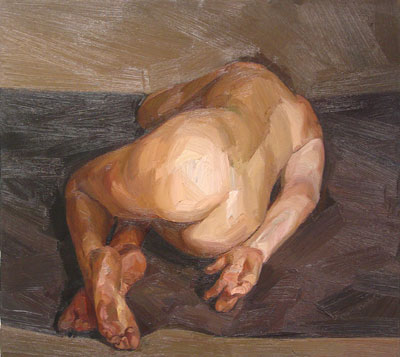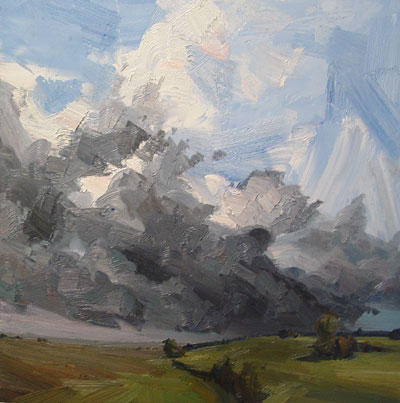Some thoughts on the future of painting
Last week, I found these two pictures on Franklin Einspruch’s Artblog.net:

While walking to YYZ that evening, I had the memory of the nude figure in mind when I thought about the materiality of painting. Through art school, I’d always hoped to become a Renaissance master, learn the techniques of glazes and sufmato. Not that I planned to paint like that for the rest of my life, but I at least wanted the ability. Of course, that ambition was a faux pas, and whenever I expressed interest in fellow painters who were good at rendering, or drafting, I usually encountered the snickers of my other painter friends. By their lack of interest in my own work, and their lack of engagement with me in terms of the craft, I knew that they thought I was a shit painter.
 My best friend was the worst at this: I knew he didn’t take me seriously, but when it comes to my talents I don’t care what other people think of me.
My best friend was the worst at this: I knew he didn’t take me seriously, but when it comes to my talents I don’t care what other people think of me.
Art has always been a form of self-entertainment, a way to kill time, a way to explore things. I create because I want something to do. After sometime doing this as a child and a teenager, you pick up some techniques, next thing you know, people are calling you an artist. So then you’re like, oh I could do this for a living, and art schools being business’ like any other, aren’t going to tell you that, no, you aren’t going to make a living as an artist. They don’t really have to, they are banking on your ambition and naivete, and there are plenty of hints that an art career is foolishness. But you think, no, I’m different, I’m good. You realize that many around you will fail, but somehow you think that you’ll succeed, even though the odds are against you. You develop a stubborn self-confidence when you go into art, because you are both na??ve and arrogant.
The stubborn self-confidence becomes really really useful. It may be one of the reasons I think art school should be a mandatory part of anyone’s education, because it humanizes you, in part because through the insecurities which you’re compensating for, you develop empathy for those around you who are also struggling towards self-confidence.
My friend, who didn’t take me seriously as a painter, never bothered to tell me why he thought my painting was shit. He dotted his professional esteem on another friend of mine, who has since decided that she’s no good as a painter and has decided to become an academic, which has led to some great conversations and some interesting and intense arguments. She and my friend shared the secret of what makes a great painting. So one night, during one these great conversations, I asked her what this was all about. A good painting, she told me, as it had been explained to her by my best friend, is about being able to represent a three dimensional image on a surface, but also about the materiality of the paint. That with a painting you can and should have both, materiality and image.
This struck me as nothing more than a 20th Century fashion, and to condemn paintings for the lack of this quality, and to hype others for it, seems shortsighted.
So these two paintings, by Tai-Shan Schierenberg, exemplify this very well. We have an image represented in space, but we also have the sensual ickyness of the paint visible. When I first saw the nude I thought it was by Lucien Freud, and a write up on his gallery’s website references that similarity. Both are British. Where Freud was born in 1922 (and will be a venerable 83 this year), Mons. Schierenberg is half that age, born in the early 1960s.
As a 20th Century fashion, we can assume that in the future historians will be able to date our paintings by this look, just as easily as we can with past centuries. We know that the 16th, 17th, 18th, and 19th Centuries have style, a theme of subject matter, a look. In the 20th Century, painting became obsessed with itself as a viscous medium resting on a surface. We don’t know what 21st Century painting will look like – this century’s look has not yet developed. It seems that in a world where all of our images are perfectly rendered on screens, the human touch evident in brushstroke and viscosity is what makes painting valuable. It occurs to me then that perhaps the traditional tales of the rise of Modernism, and especially Ab-ex painting in the 1950s, ignores the concurrent development of television. These things make me think that this style has legs to go into the 21st Century.
At the same time, we 20C folk are limited to thinking of everything as ‘human touch’ and go on and on about ‘humanity’ – this vast 19th C hangover of industrialization. We’re at a point now as a society that people enjoy sex that much more when it’s filmed and public. Whenever we are tempted to use the word ‘traditional’ we should stop and ask ourselves if this tradition isn’t rooted in the 1800s or earlier. I think that by the time I’m Lucian Freud’s age (2058) folk’ll be printing paintings they design with whatever grandchild of Illustrator has been developed … which they are already doing now, but aren’t being taken seriously. I think what I find most shocking as we move into the future is how much and how many traditions are falling away, or becoming so evidently obsolete as to have no hold on the young.
Having found a porn vid on the net consisting of some girl having sex in a nightclub with a male stripper, while girls over at the other table ignore it as if they were simply making out, unsettles one’s perceptions of the world, of what’s predictable, and of the wildness that is out there in our society now. The Instant Coffee make-out parties seem chaste by comparison. Orgies have had a place in civilization throughout the centuries, but after 150 years of Victoriana, marked by health scares, this old human behavior reasserting itself reminds us that our traditions are merely fashions that pass through generations as if they were the cut of a collar.
And the point I’m trying to make here, is that I’m under the impression that the kids (those under 25) don’t care. They don’t care about our traditions, our ways of describing things. I say ‘our’ as someone born in the 70s, near the end of the Gen X scale, as a thoroughly 20th Century individual. I say that as someone who’s turning 30 at the end of the month, that age which could not be trusted 40 years ago.
The kids (18-25 and younger) grew up with Nike telling them to just do it, and it seems to be their philosophy. They’re just gonna do it. If they want to print a painting, they will. They’re not going to give a shit about a discourse on the medium, they’re not gonna give a shit about art history. Indeed, the one thing that seems significant here is how little history seems to be involved.
As a child in the ’80s, ’40 years ago’ was World War II. My first experience of the history of the world, of the century, was that there’d been this great war ’40 years ago’. As I got older, I had to modify that lesson, so now, World War II was sixty years ago, and, to my shock, the 1960s (which had been ’20 years ago’) are forty years past. History for me is a gauge of experience, a reference point for TV shows and the news. For a younger generation, 20 years ago is colour footage of Live Aid, an indistinct memory of a world run by Grandpa Reagan, and of the earliest music videos.
One can’t see past the colour film stock of the late 1960s. I’m guessing here, but I’m thinking our future adult society thinks black & white is lame. I for one think black & white, now best called ‘grayscale’, is lame most of the time. So, I’m sympathetic to these challenges to tradition, habit, and academic fashion. Far from being conservative and feeling disgust or condemnation, I’m excited about this feeling of wild possibility. I see myself living through a transitional time which is even more significant than the industrial revolution of the 19th Century. As we move into what Greg Bear called in his novels, ‘the Dataflow Culture’.
Unfortunately, these quality-of-life technologies allow a sense of irresponsibility, because you can forget phone numbers or details that can be called up from anywhere at anytime. People can fuck around and smoke and whatever, because they’ll probably have disease licked in 30 years. But let’s hope that a feeling of duty toward others is ingrained enough in our psychologies that Prada Princess monsters and Paris Hilton Aintoniettes are late 20th Century aberrations, a product (like all other 20C products) not built to last.
Hi!
This is really good work..I love it.am also fine artist..and appriceate the work…
can i see other work…am sure that will learn something from ur work…
Thanks!
hi,good brush effects,
your style is good,colour mix is cool,but on what is the model lying on?i mean,if it is an imaginative composition,the lady in the painting is sleeping on what surface?rock or bed?
Dudes, that’s not his work.
Great article, I completely agree with everything you are saying, being a painter myself. Painting will become a sum of all its parts. Just my two cents.
It is ironic the first two readers did’nt even read the text, this is kind of what the whole thing is about.
As a painter myself, sometimes it gets me down that the majority of young people do not give a shit about painting (with a brush anyway).
It is turning in to a plastic,art of conversation is dead,lazy,cheap ,must have, don’t need to read the book-ripped the DVD,I’m a clone,fast food,buy now pay later,disrespectful,could’nt be fucked doing it myself so I stole it,take the easy way,I know it all but I have no real life experiance,computer game type of society.
Hi i’m 21 and at art school and i really do give a shit about painting with a brush. I paint large scale, tradtitional style landscapes and have been an admirer of Tai-Shan Schiernbergs work for years. I believe that traditional painting is comeing back, well at least im relying on that for hope of makeing money out of my work one day